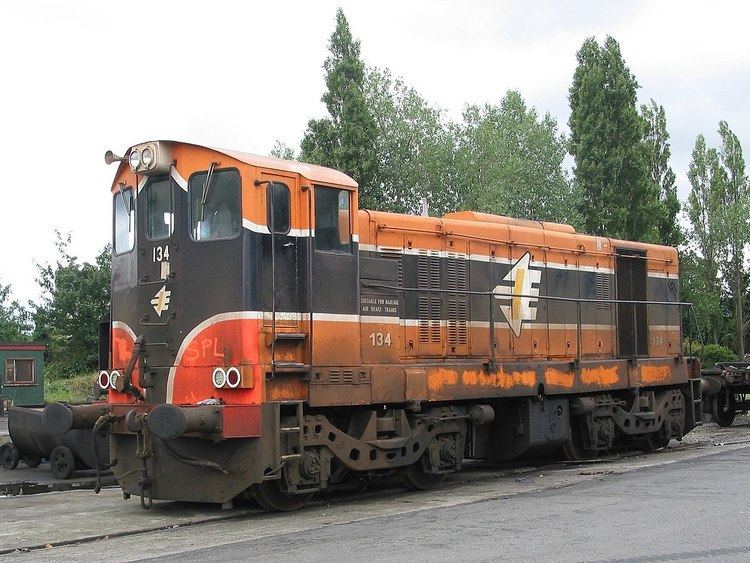Power type Diesel-electric Serial number 26271–26285 | Order number 702667–702681 Model EMD GL8 | |
 | ||
Builder General Motors Electro-Motive Division, La Grange, Illinois, USA Build date December 1960 – January 1961 | ||
The Córas Iompair Éireann 121 Class was a railway locomotive which was manufactured by General Motors Electro-Motive Division. These locomotives were in regular service on the Irish railway network until 2002, with the last two remaining in service until 2008.
Contents
History.
The 121 Class locomotives were manufactured in December 1960 and January 1961 and numbered B121 to B135. The last two locomotives that survived in traffic (Nos. 124 and 134) were both withdrawn from service on 3 May 2008. Prior to 1961, almost all Irish diesel locomotives were built in Great Britain, but from the 1960s onwards, GM became the sole supplier of locomotives to CIÉ, which eventually also extended to Northern Ireland Railways locomotives at a later stage. These were EMD's first ever fully American-built locomotives delivered to Europe.
The Class 121 locomotives were a typical American-style single cab ‘road switcher'. The layout of the cab was quite different from the other conventional CIÉ diesel models of the time, with the controls to the side of the driver, rather than the front. Due to apparent driver complaints of reduced visibility when operating with cab trailing, it was ultimately decided that these locomotives should only operate in a cab-leading formation. Later conversion for multiple-unit working allowed two 121 class locomotives to be coupled hood-end to hood-end, removing the need to turn them around for their return journey.
Although originally fitted with an EMD 8-567CR engine of 960 horsepower (720 kW), all were later fitted with 645 type "power packs" (piston & liner assemblies) for parts standardisation, while at the same time keeping their original power output for reliability reasons. They weighed 64 tonnes (63.0 long tons; 70.5 short tons) and had a maximum speed of 123 km/h (76 mph). Numbers 126-129 were later rebuilt with an EMD 8-645E engine of 1,100 horsepower (820 kW); as used in the 181 Class locomotives.
All but three (121, 125, and 135) were fitted with Train Door Control equipment for operation with the Inchicore-built, BR Mark 3 based, Push-Pull train units. The push-pull equipment of locomotive 132 was subsequently decommissioned. Entering service in 1989, these trains, consisting of a single 121 Class and up to six carriages, were mainly used on the Dublin northern suburban passenger railway service. These were to be the last regular passenger duties for the 121s within Greater Dublin. The Limerick shuttle continued to be worked by 121s for several years after this date. In 1994, a railcar "revolution" had begun, and the push pull carriages were later re-deployed to inter-city duties with the 201 Class locomotives.
Withdrawal
The first member of the class to be withdrawn was 125 in 1986 following an electrical fire, though it had been extensively damaged in an accident twelve years previously. However it was not scrapped until 2002.
By 1995, the class 201 had replaced the class 121 on most passenger routes. Throughout the late 1990s the fleet dwindled, and by 2005 only numbers 124 and 134 remained in service, with number 123 in storage for five years until eventually being scrapped in 2008. The rest of the fleet has since been scrapped, due to the ongoing decline in freight traffic that they were also used for.
Their last official scheduled mainline passenger working was on Saturday, 9 July 2005 on the Sligo line. The last known passenger working of this class was the 13:15 Waterford-Heuston service on 18 January 2007. Previously, these locomotives had filled in on the Manulla-Ballina service or the occasional service from Limerick.
The very last use of them in public service was in the early months of 2008 on maintenance trains - by this stage 124 and 134 were the only survivors. Both were retired by degrees and officially withdrawn in July 2008, though at this stage neither had done much for many weeks.
Preservation
The Irish Traction Group has preserved one member of this class, No.124. It is located at Moyasta junction on the preserved West Clare Railway.
The other surviving member of the class, No.134, is owned by and was earmarked for preservation by the Railway Preservation Society of Ireland., On 19/07/2016, it was hauled by 071 Class No. 071 from Inchicore to the RPSI's locomotive shed at Dublin Connolly. As of late 2016, work is continuing to restore it for mainline railtour use, along with the other preserved 141-class locos.
The cab of No.133 is preserved at the Cavan & Leitrim Railway in Dromod, County Leitrim.
Livery
On delivery, the locomotives were painted in a Yellow and Grey livery. This was replaced within a year by a black / tan (“golden brown”) colour scheme with a thick white band similar to the Cravens coaching stock, delivered in 1963. With time, the colour scheme changed to tan with a black band. Soon after CIÉ Rail services became known as Irish Rail, the colour scheme was enhanced when two white bands (approx. 25 mm / 1") separating the colours were added. At the same time, as a safety aspect, self-adhesive high-visibility panels were added to the front of the Locomotives.
Model
The 121 Class has been made as a 00 gauge Whitemetal kit by Model Irish Railways.[1].
Murphy Models have announced plans to release an '00' gauge ready to run model of the 121 class.
